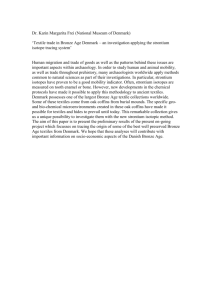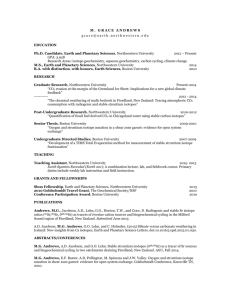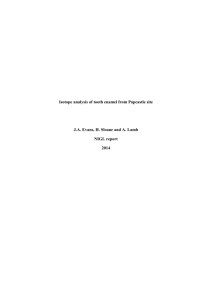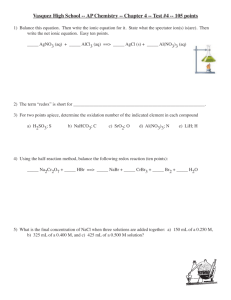Strontium Isotope Analysis
advertisement
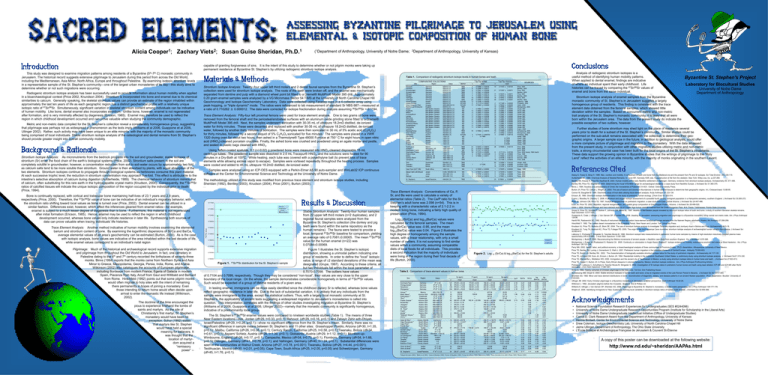
Alicia Cooper1; Zachary Viets2; Susan Guise Sheridan, Ph.D.1 (1Department of Anthropology, University of Notre Dame; 2Department of Anthropology, University of Kansas) capable of granting forgiveness of sins. It is the intent of this study to determine whether or not pilgrim monks were taking up permanent residence at Byzantine St. Stephen’s by utilizing radiogenic strontium isotope analysis. This . study was designed to examine migration patterns among residents of a Byzantine (5th-7th C) monastic community in Jerusalem. The historical record suggests extensive pilgrimage to Jerusalem during this period from across the Old World, including the Mediterranean, Asia Minor, North Africa, Europe and throughout Palestine. By examining isotopic strontium levels in a representative sample of the St. Stephan’s community—one of the largest urban monasteries of its day—this study aims to determine whether or not such migrations were occurring. Radiogenic strontium isotope analysis has been successfully used to provide information about human mobility when applied in a bioarchaeological context (Price 2002, Knundson 2004). Strontium is incorporated into bone and enamel due to its chemical similarities to calcium. Generally speaking, the skeletal strontium values can provide an estimate of the region inhabited within approximately the last ten years of life as each geographic region has a distinct geochemical profile with a relatively unique isotopic ratio of 87Sr/86Sr. Simultaneously, significant variation in skeletal strontium content among individuals can be indicative of human mobility. Like bone, dental enamel also incorporates strontium. Unlike bone, however, enamel is not regenerated after formation, and is very minimally affected by diagenesis (Ericson, 1985). Enamel may therefore be used to reflect the region in which childhood development occurred and can prove valuable when studying the community demographic. Metric and non-metric data compiled for the St. Stephen’s collection reveal a considerably homogeneous group, suggesting that pilgrimage was perhaps not as widespread a phenomenon as the texts imply (Williams et al 2006, Guappone et al 2006, Ullinger 2002). Rather, such activity may have been unique to an elite minority, with the majority of the monastic community being comprised of local individuals. Stable strontium isotope analysis of the osteological and dental remains from St. Stephan’s should provide greater insight into overall community mobility. Strontium Isotope Analysis: As micronutrients from the bedrock progress into the soil and groundwater, stable isotopes of strontium (Sr) enter the food chain of the earth’s biological systems (Price, 2002). Strontium salts present in the soil are completely soluble in groundwater; however, a concentration reduction from soil to soil-water occurs by approximately two fold, as calcium salts tend to be more soluble than strontium. Ground water is then absorbed by plants, with equal absorption of the two elements. Strontium isotopes continue to propagate through biological systems as herbivores consume this plant material. At each successive trophic level, the reduction in strontium concentration may approach five-fold. This effect is attributable to the intestine’s selective absorption of calcium during digestion (Aufderheide, 1989). The chemical behavior of strontium mimics that of calcium, often substituting for this rare earth in the hydroxyapatite crystal matrix (Knudson, 2004). Consequently, the 87Sr/86Sr ratios of calcified tissues will indicate the unique isotopic composition of the region occupied by the individual prior to death (Price, 1994). Table 1. Comparison of radiogenic strontium isotope levels in human bones and teeth Site Strontium Isotope Analysis: Twenty–four upper left third molars and 2 dental faunal samples from the Byzantine St. Stephen’s collection were used for strontium isotope analysis. The roots of the teeth were broken off, and the enamel was mechanically separated from dentine and pulp with a diamond wheel point bit fitted to a Dremel® MultiPro® Model 395 drill. Approximately 0.20 gram enamel samples were analyzed by a VG Micromass Sector 54 TIMS at the University of North Carolina Chapel Hill Geochronology and Isotope Geochemistry Laboratory. Data were collected using Faraday cups in a 4-collector array using peak-hopping, or "triple dynamic" mode. The ratios were referenced to lab measurement of standard Sr NBS-987—measured at a ratio of 0.710262 ± 0.000012. The data were corrected for isotope fractionation during analysis assuming 86Sr/88Sr = 0.1194. The doctrine of the time encouraged the pious to experience firsthand the tombs of saints and martyrs. As the site of Christianity’s first martyr, St. Stephen’s monastery would have been no exception. Schur (1992) states that martyrs like St. Stephen would have held a special meaning for believers. It was thought that the location of martyrdom acquired a “remissory power” -- Sr/86Sr BONE Region Dates n TIMS TIMS TIMS TIMS TIMS TIMS TIMS TIMS ICP-MS ICP-MS ICP-MS TIMS MS MS MS MS MS MS MS MS MS MS MS MS TIMS TIMS ICP-MS MS MS MS MS MS 5 6 6 7 7 7 14 25 11 2 11 41 21 54 16 2 2 mean n ± 0.00019 ± 0.00017 ± 0.00036 ± 0.00036 ± 0.00012 ± 0.00012 ± 0.00020 ± 0.00022 ± 0.00020 ± 0.00007 ± 0.00000 -0.70962 ± 0.00000 0.70824 ± 0.00014 0.70943 ± 0.00054 0.70908 ± 0.00020 0.70924 ± 0.00036 0.70880 ± 0.00016 0.70920 ± 0.00017 0.70998 ± 0.00000 0.71016 ± 0.00020 0.70985 ± 0.00000 0.70875 ± 0.00015 -0.70892 ± 0.00015 -0.71047 ± 0.000702 0.71985 ----- 10 ± 0.00013 ± 0.00040 ± 0.00275 ± 0.00050 ± 0.000329 ± 0.00011 --- 26 SOURCES mean 6 3 2 1 10 0.70583 ± 0.00110 --0.71110 ± 0.00190 0.71081 ± 0.00000 0.70849 ± 0.00100 0.70765 ± 0.00110 0.71454 ± 0.00835 Price, 2000 Price, 2000 Ezzo, 2002 Price, 2002 (bone); 1994 (teeth) Price, 1994 Ericson, 1985 Ericson, 1985 Price, 2006 -0.71236 -- 83 2 10 0.70804 ± 0.00122 0.71329 ± 0.00090 0.70757 ± 0.00120 Wright, 2005 Knudson, 2005 Knudson, 2004 1 0.70938 ± 0.00002 1 0.70970 ± 0.00002 Sealy, 1995 5 5 5 0.70819 ± 0.00001 0.70797 ± 0.00013 0.70830 ± 0.00014 5 5 5 0.70818 ± 0.00001 0.70854 ± 0.00066 0.70821 ± 0.00003 Perry, 2002 Perry, 2002 Perry, 2002 -- 22 0.70843 ± 0.00069 Mexico Wisconsin, US Arizona, US Arizona, US Arizona, US California, US California, US Mexico 1-650 C.E. 1050-1250 C.E. 1299 C.E. 1300 C.E. 1300 C.E. 1600-1800 C.E. 1600-1800 C.E. 1500-1700 C.E. TIMS TIMS MS TIMS TIMS MS MS TIMS Tikal Tiwanaku Tiwanaku Guatemala Bolivia Bolivia 500-950 C.E. 500-1100 C.E. 500-1100 C.E. TIMS TIMS TIMS 1 Samples were analyzed using an ICP-OES equipped with a Perkin-Elmer AS 90 auto-sampler and WinLab32 ICP continuous software at the Center for Environmental Science and Technology at the University of Notre Dame. Cape Town (UCT 169) South Africa 1400 C.E. MS Zabayir Zahir edh-Dhiyab Aila Rehovot Jordan Jordan Israel 0-400; 500-600 C.E. 300-650 C.E. 300-650 C.E. MS MS MS The methodology utilized in this study was modified from previous trace element and strontium isotope studies, including Sheridan (1992), Bentley (2003), Knudson (2004), Price (2001), Burton (2003). St. Stephen's Israel/Palestine 438-630 C.E. Using Teflon-coated spatulas, 0.1 (+/-0.02) g powdered bone were measured into HNO3-cleaned disposable 15 mL centrifuge tubes. The powdered sample was dissolved in 2.0 mL Tracepur® HNO3, and the solutions were heated for 90 minutes in a Dry-Bath at 100ºC. While heating, each tube was covered with a polyethylyne ball (to prevent loss of trace elements while allowing excess vapor to escape). Samples were vortexed repeatedly throughout the heating process. Samples were cooled and added to 45 mL ultrapure 18.2mΩ distilled, de-ionized water. Sr/86Sr TOOTH Price, 2001 Bentley, 2004 Price, 2001 Bentley, 2004 Price, 2001 Bentley, 2004 Price, 2001 Bentley, 2004 Latkoczy, 1998 Prohaska, 2002 Giblin, 2004 Montgomery, 2000 Grupe,1997 Grupe,1997 Grupe,1997 Grupe,1997 Grupe,1997 Grupe,1997 Grupe,1997 Grupe,1997 Grupe,1997 Grupe,1997 Grupe,1997 Evans, 2006 Schweissing, 2003 Montgomery, 2005 Prohaska, 2002 Aberg, 1998 Aberg, 1998 Aberg, 1998 Aberg, 1998 Aberg, 1998 Teotihuacan Aztalam Grashopper Pueblo Grashopper Pueblo Walnut Creek Malibu Century Ranch Campeche Trace Element Analysis: Fifty-four left proximal femora were used for trace element analysis. One to two grams of bone were removed from the femoral shaft and the periosteal/endosteal surfaces with an aluminum oxide grinding stone fitted to a Dremel® MultiPro® Model 395 drill. Next, the samples underwent sonication with 30-35 mL of ultrapure 18.2mΩ distilled, de-ionized water for thirty minutes. These were decanted and replaced with another 30-35 mL of ultrapure 18.2mΩ distilled, de-ionized water, followed by another thirty minutes of sonication. The samples were then sonicated in 30 mL of 5% acetic acid (C2H4O2) for thirty minutes, followed by a second aliquot of 5% C2H4O2 sonicated for five minutes. The samples were placed in a VWR 1320 drying oven for about two hours, then ashed in a Thermolyne® Type 48000 Furnace at 750 C for eight hours in open nitric acid (HNO3)-cleaned porcelain crucibles. Finally, the ashed bone was crushed and powdered using an agate mortar and pestle, and sealed in plastic bags cleaned with HNO3. 87 0.71072 ± 0.00125 -0.71007 ± 0.00071 -0.70915 ± 0.00071 0.70914 ± 0.00079 0.70942 ± 0.00053 0.70943 ± 0.00051 -0.71405 ± 0.00403 0.70942 ± 0.00020 0.70855 ± 0.00071 0.70967 ± 0.00060 0.70967 ± 0.00060 0.70967 ± 0.00060 0.70967 ± 0.00060 0.70967 ± 0.00060 0.70967 ± 0.00060 0.70967 ± 0.00060 0.70967 ± 0.00060 0.70967 ± 0.00060 0.70967 ± 0.00060 0.70967 ± 0.00060 0.71219 ± 0.00650 0.70968 ± 0.00133 0.70942 ± 0.00072 0.70987 ± 0.00116 -0.71976 0.73232 0.71087 0.72359 Germany Germany Germany Germany Germany Germany Germany Germany Austria Austria Hungary England Bell Beaker, Bell Beaker, Bell Beaker, Bell Beaker, Bell Beaker, Bell Beaker, Bell Beaker, Bell Beaker, Bell Beaker, Bell Beaker, Bell Beaker, England Bavaria England Austria Norway Norway Norway Norway Norway Bavaria Bavaria Bavaria Bavaria Bavaria Bavaria Bavaria Bavaria Bavaria Bavaria Bavaria 5200 B.C.E. 5200 B.C.E. 5200 B.C.E. 5000 B.C.E 5200 B.C.E. 5200 B.C.E. 5200 B.C.E. 5200 B.C.E. 5000 B.C.E 5000 B.C.E 4500-4000 B.C.E. 4000 B.C.E. 2500-2000 B.C.E. 2500-2000 B.C.E. 2500-2000 B.C.E. 2500-2000 B.C.E. 2500-2000 B.C.E. 2500-2000 B.C.E. 2500-2000 B.C.E. 2500-2000 B.C.E. 2500-2000 B.C.E. 2500-2000 B.C.E. 2500-2000 B.C.E. 300-400 C.E. 330-400 C.E. 400-600 C.E. 400-500 C.E. 1100 C.E. 1200 C.E. 1250 C.E. 1250 C.E. 1400 C.E. Method Flomborn Flomborn Schwetzingen Schwetzingen Dillingen Dillingen Vaihingen Vaihingen Asparn/Schletz Asparn/Schletz Great Hungarian Plain Monkton-up-Wimbourne Altdorf Augsburg Irlbach Kunzing-Bruck Landau Manching Osterhofen Pommelsbrunn Straubing-Oberau Tuckelhausen Weichering Lankhills Neuburg/Donau West Helerton Globasnitz Hїre kraine Ringebu 3A Uvdal Bergen Ringebu 3B 0.70995 0.70995 0.70941 0.70941 0.70865 0.70865 0.70959 0.70959 0.71030 0.71110 0.70922 1 11 11 11 11 11 11 11 11 11 11 70 3 1 0.70472 0.70102 0.71011 0.71018 0.70931 0.70884 TIMS 21 17 17 16 46 2 13 14 76 76 76 76 76 76 76 76 76 76 76 18 70 41 3 1 1 1 1 Byzantine St. Stephen’s Project Laboratory for Biocultural Studies University of Notre Dame Department of Anthropology Strontium isotope analysis of enamel samples from the Byzantine monastic community of St. Stephen’s in Jerusalem suggests a largely homogenous group of residents. This finding is consistent with the trace element data obtained from the femoral samples, which showed little deviation within the samples. Based on concurrent metric and non-metric trait analysis of the St. Stephen’s monastic community, it is likely that all were born within the Jerusalem area. The data from the present study do indicate the possible exception of two outliers, however. Further studies of bone strontium may shed light on the place of residence several years prior to death for a subset of the St. Stephen’s community. Similar studies could be performed on the sub-adult remains associated with the collection to determine their geographic origins. A larger sample size in the future, in addition to geological analysis, could offer a more complete picture of pilgrimage and migration to the monastery. With the data amassed from the present study, in conjunction with other migration studies utilizing metric and non-metric traits, a strong circumstantial case has been built for the local origins of the St. Stephen’s inhabitants. These data support the growing opinion in Byzantine studies that the writings of pilgrimage to the “Holy Land” reflect the activities of an elite minority, with the majority of monks originating in the southern Levant. Aberg G, Fosse G, Stray H. 1998. Man, nutrition and mobility: A comparison of teeth and bone from the Medieval era and the present from Pb and Sr isotopes. Sci Total Environ 224:109-119. Aufderheide AC. 1989. Chemical Analysis of Skeletal Remains. In: Iscan MY, Kennedy KAR, eds. Reconstruction of life from the skeleton. New York: Wiley-Liss, Inc. p.237-260. Bentley RA, Krause R, Price TD, Kaufman B. 2003. Human mobility at the early Neolithic settlement of Vaihingen, Germany: evidence from strontium isotope analysis. Archaeometry 45: 471-486. Bentley RA, Price TD, Stephan E. 2004. Determining the 'local' 87Sr/86Sr range for archaeological skeletons: a case study from Neolithic Europe. J Archaeol Sci 31:365-375. Binns J. 1994. Ascetics and ambassadors of Christ: the monasteries of Palestine 314-631. Oxford: Oxford University Press. 0.711000 0.710500 0.710000 87Sr/86Sr values 0.709500 0.709000 0.708500 0.708000 0.707500 Pilgrimage: Much of the historical and archaeological record supports extensive migration and pilgrimage from throughout the Old World to Jerusalem. In fact, one cemetery in Palestine dating to the 6th and 7th century recorded the birthplaces of seventy-three monks. Binns (1994) reports that the monks came from Northern Syria and Asia Minor to Greece, Mesopotamia, Georgia, Persia, India, Rome, and Arabia. Wilkinson (2002) also catalogues the accounts of European pilgrimage, including Bordeaux from modern France, Egeria of Galacia in modern Spain, Piacenza from Italy, Arculf from Gaul and Willibald and Bernard from Rome. Hirschfeld (1992) points out that some pilgrim monks would often migrate to holy sites with the intent of remaining there permanently in hopes of joining a monastery. Even those intending to return home would often decide upon arrival to enter the monastic life instead (Wilkinson, 2002). 87 COMPARATIVE COLLECTIONS Bone is continually replaced, with cortical and trabecular bone maintaining half-lives of 23.1 years and 2.9 years, respectively (Price, 2000). Therefore, the 87Sr/86Sr value of bone can be indicative of an individual’s migratory behavior, with the strontium ratio shifting toward local values as bone is turned over (Price, 2002). Dental enamel can be utilized in a similar fashion. Differences exist, however, which affect the inferences gleaned from enamel ratios—for example, enamel is subject to a much lesser degree of diagenesis than is bone. Furthermore, this material is not regenerated after initial formation (Ericson, 1985). Hence, enamel may be used to reflect the region in which childhood development occurred, whereas bone values only indicate residence in later life. Synthesizing both sources of data can prove valuable when tracing individuals’ life histories. Trace Element Analysis: Another method indicative of human mobility involves examining the elemental barium and strontium content of bone. By examining the logarithmic dispersions of Sr/Ca and Ba/Ca, average elemental values of an area’s geochemistry can be estimated (Burton, 2003). As is the case with isotopic analysis, bone values are indicative of the area inhabited within the last decade of life, while enamel values correspond to an individual’s natal region Analysis of radiogenic strontium isotopes is a useful method of identifying human mobility patterns. When applied to dental enamel, findings are indicative of where an individual spent their early childhood. Life histories can be traced by comparing the 87Sr/86Sr values of enamel and bone from the same individual. Local Non-local Faunal Local Range Stable Strontium Analysis: Twenty-four human samples from 22 upper left third molars (n=2 duplicates), and 2 regional faunal samples were analyzed from the Byzantine St. Stephen’s collection (the donkey and pig teeth were found within the same repository as the human remains). The fauna were tested to provide a local, temporal 87Sr/86Sr baseline for comparison, yielding an average ratio of 0.70810.00005. The mean 87Sr/86Sr value for the human enamel (n=22) was 0.070840.00069. Figure 1 illustrates the St. Stephen’s isotopic 0.707000 distribution, showing a unimodal pattern indicating one group of residents. In order to define the “local” isotopic 0.706500 value, a range of 2 standard deviations of the mean was Figure 1. 87Sr/86Sr distribution for the St. Stephen’s sample designated (Grupe, 1997). According to these criteria, all but two individuals fall within the local parameter of 0.7070-0.7098. The outliers have values of 0.7104 and 0.7099, respectively. Though they may be considered “non-local”, their values are very close to the upper boundary of the local range. On the whole, the sample demonstrates considerable homogeneity in terms of 87Sr/86Sr values. Such would be expected of a group of lifetime residents of a given area. In testing enamel, immigrants can be more easily identified since the childhood dietary Sr is reflected, whereas bone values reflect geographic residence in later life. Due to the lack of substantial variation, it is unlikely that any individuals from the sample were immigrants to the area, except the statistical outliers. Thus, with a largely local monastic community at St. Stephen’s, the applicability of ancient texts suggesting a widespread migration to Jerusalem’s monasteries is called into question. This interpretation correlates with the findings of other studies investigating migration at Byzantine St. Stephen’s (Williams et al 2006, Guappone et al 2006, Ullinger 2002)—namely that the monastic community is significantly homogenous, indicative of a predominantly local group. The St. Stephen’s 87Sr/86Sr enamel values were compared to nineteen worldwide studies (Table 1). The means of three Near Eastern locations—Aila, Jordan (df=29, t=0.33, p<0.1); Rehovot (df=29, t=0.16, p<0.1) and Zabayir Zahir edh-Dhiyab, Israel/Palestine (df=29, t=0.28, p<0.1)—show no significant difference from the St. Stephen’s mean. Similarly, there was no significant difference in sample means between St. Stephen’s and 11 other sites: Grasshopper Pueblo, Arizona (df=30, t=1.35, p<0.1); Malibu, California (df=26, t=0.08, p<0.1); Century Ranch, California (df=25, t=0.58, p<0.1);Tiwanaku, Bolivia (df=34, t=0.61, p<0.1); Asparn/ Schletz, Austria (df=26, t=1.39, p<0.1); Globasnitz, Austria (df=29, t=1.12, p<0.1); Monkton-upWimbourne, England (df=38, t=0.17, p<0.1); Campeche, Mexico (df=34, t=0.73, p<0.1); Flomborn, Germany (df=34, t=1.66, p<0.1); Dillingen, Germany (df=41, t=0.79, p<0.1); and Vaihingen, Germany (df=40, t=1.24, p<0.1). Substantial differences were seen in the communities at Walnut Creek, Arizona (df=27, t=3.78, p>0.001); Tiwanaku, Bolivia (df=26, t=4.44, p>0.001); Teotihuacán, Mexico (df=30, t=2.01, p=0.05); Cape Town, South Africa (df=25, t=2.05, p=0.05) and Schwetzingen, Germany (df=45, t=1.76, p>0.1). Trace Element Analysis: Concentrations of Ca, P, Sr, and Ba were used to calculate a variety of elemental ratios (Table 2). The Ca/P ratio for the St. Stephen’s adult bone was 2.098 (n=54). This is in keeping with a characteristic value of 2.1-2.2 in modern living bone, indicating a fairly high quality of preservation (Price, 1994). Burton JH, Price TD, Cahue L, Wright LE. 2003. The use of barium and strontium Abundances in human skeletal tissues to determine their geographic origins. Int J Osteoarchaeol 13:88-95. Connor M, Slaughter D. 1984. Diachronic study of Inuit diets utilizing trace element analysis. Arctic Anthropol 21:123-134. -2 Ericson JE. 1985. Strontium isotope characterization in the study of prehistoric human ecology. J Hum Evol 14: 503-514. Evans J, Stoodley N, Chenery C. 2006. A strontium and oxygen isotope assessment of a possible fourth century immigrant population in a Hampshire cemetery, southern England. J Archaeol Sci 33:265-272. Ezzo JA, Johnson CM, Price TD. 1997. Analytical perspectives on prehistoric migration: a case study from East-Central Arizona. J Archaeol Sci 24:447-466. -2.5 Ezzo JA, Price TD. 2002. Migration, regional reorganization, and spatial group composition at Grasshopper Pueblo, Arizona. J Archaeol Sci 29:499-520. Giblin J. 2004. Strontium isotope and trace element analysis of Copper Age human skeletal material from the Great Hungarian Plain. M.A.Thesis. Tallahassee: Florida State University. -3 Grupe G, Price TD, Schroter P, Sollner F, Johnson CM, Beard BL. 1997. Mobility of Bell Beaker people revealed by strontium isotope ratios of tooth and bone: a study of southern Bavarian skeletal remains. Appl Geochem 12:517-525. Guappone A, Crate J, Ullinger J, Van Gerven DP, Sheridan SG. 2006. Heading to Jerusalem: assessing migration and pilgrimage to a Byzantine monastery using cranial non-metric traits. Am J Phys Anthropol 129:96. -3.5 Log10(Sr/Ca) and log10(Ba/Ca) values were calculated for the femoral samples. The mean log10(Sr/Ca) value was -0.95, and the mean log10(Ba/Ca) value was 0.04. Figure 2 illustrates the high degree of homogeneity among the sample values, with a linear relationship, with only a small number of outliers. It is not surprising to find similar values within a community, assuming comparable diets of local foods for all individuals. This provides a second indication that the majority of individuals were living in the region during their final decade of life (Burton, 2003). Harritt RK, Radosevich SC. 1992. Results of instrument neutron-activation trace-element analysis of human remains from the Naknek Region, southwest Alaska. Am Antiquity 57:288-299. Hirschfeld Y. 1992. The Judean desert monasteries in the Byzantine Period. New Haven and London: Yale University Press. -4 Knudson KJ, Price TD, Buikstra JE, Blom DE. 2004. The use of strontium isotope analysis to investigate Tiwanaku migration and mortuary ritual in Bolivia and Peru. Archaeometry 46:5-18. Knudson KJ, Tung TA, Nystrom KC, Price TD, Fullagar PD. 2005. The origin of the Juch’uypampa Cave mummies: strontium isotope analysis of archaeologcial human remains from Bolivia. J Archaeol Sci 32:903-913. -4.5 Latkoczy C, Prohaska T, Stingeder G, Teschler-Nicola M. 1998. Strontium isotope ratio measurements in prehistoric human bone samples by means of high-resolution inductively coupled plasma mass spectrometry (HR-ICP-MS). J Anal Atom Spectrom 13:561-566. Log(Ba/Ca) -5 Log(Sr/Ca) Montgomery J, Budd P. 2000. Reconstructing the lifetime movements of ancient people: a Neolithic case study from southern England. Eur J Archaeol 3:370-385. Montgomery J, Evans JA, Powlesland D, Roberts CA. 2005. Continuity or colonization in Anglo-Saxon England? Isotope evidence for mobility, subsistence practice, and status at West Heslerton. Am J Phys Anthropol 126:123-138. Perry MA. 2002. Health, labor, and political economy: a bioarchaeological analysis of three communities in Provincia Arabia. Ph.D. dissertation. Albuquerque: University of New Mexico. -5.5 Price TD, Bentley RA, Luning J, Gronenborn D, Wahl J. 2001. Prehistoric human migration in the Linearbandkeramik of Central Europe. Antiquity 75:593-603. Figure 2. Log 10 (Sr/Ca) & log10(Ba/Ca) for the St. Stephen’s adults Price TD, Burton JH, Bentley RA. 2002. The characterization of biologically available strontium isotope ratios for the study of prehistoric migration. Archaeometry 44:117-135. Price TD, Johnson CM, Ezzo JA, Ericson J, Burton JH. 1994. Residential mobility in the prehistoric Southwest United States: a preliminary study using strontium isotope analysis. J Archaeol Sci21:315-330. Price TD, Manzanilla L, Middleton WD. 2000. Immigration and the ancient city of Teotihuacan in Mexico: a study using strontium isotope ratios in human bone and teeth. J Archaeol Sci 27:903-913. Price TD, Tiesler V, Burton JH. In Press. Early African diaspora in colonial Campeche, Mexico: strontium isotopic evidence. Am J Phys Anthropol (Forthcoming Article). Prohaska T, Latkoczy C, Schultheis G, Tescher-Nicola M, Stingeder G. 2002. Investigation of Sr isotope ratios in prehistoric human bones and teeth using laser ablation ICP-MS and ICP-MS after Rb/Sr separation. J Ann Atom Spectrom 17:887-891. Schur N. 1992. Twenty centuries of Christian pilgrimage to the Holy Land. Tel Aviv: Dvir Publishing House. Table 2. Comparison of trace element values in human bone Site Ca (ppm) Atoyac10 Black Mesa2 Kanimaljuyu 10 Tikal 10 Pueblo Grande 3 Browerville 4 Utqiagvik 4 Kipuqlak 4 W. Thule4 Kugok 4 Ipiutak 4 Tarascan' Atoyac 10 Urichu 10 Agua de Dios 5 Cape Penninsula Cape Point 6 Elands Bay 6 Kulubnarti Gordan's Bay 6 Blouberg 6 Clanwilliam 6 La Concepcion 5 La Palma 7 Tenerife 5 Espigon 7 Barranco Porto 7 6 Umm el-Jimal 8 Umm el-Jimal 8 St. Stephen's 1 Sr (ppm) Ba/Ca Sr/Ca log (Ba/Ca) log (Sr/Ca) 2.19 2.31 2.23 2.18 0.23 0.24 0.26 0.27 0.48 0.82 0.77 1.21 -0.64 -0.62 -0.59 -0.57 -0.32 -0.09 -0.11 0.08 24.55 21.00 107.15 21.88 188.00 ± 196.68 ------------19.50 5.89 --1.96 ----2.13 ----------------- --0.08 ----0.05 ----------------- --0.55 ----0.56 0.40 0.68 1.68 0.51 0.72 1.06 ----- -1.19 -1.11 -0.55 -1.24 -1.30 -------------1.29 -1.81 0.0302 -0.26 -0.17 -0.93 -0.25 -0.40 -0.17 0.22 -0.29 -0.14 0.03 0.02 -0.01 226.70 ± 136.70 368.73 ± 128.51 343.86 327.98 190.57 ± 36.335 765.48 356.82 253.98 ± 47.80 283.80 ± 69.40 119.40 ± 43.30 48.30 ± 13.90 140.80 ± 72.50 505.10 ± 213.80 196.30 ± 142.70 12.67 ± 2.82 4.33 8.25 29.63 ± 12.93 18.60 19.07 22.455 ± 9.93 281.20 ± 184.70 7.70 ± 1.10 63.90 ± 16.90 15.70 ± 8.90 14.80 ± 8.90 --------------------------- 0.80 0.05 0.02 0.03 0.08 0.08 0.09 0.10 1.11 0.03 0.24 0.07 0.06 0.92 1.59 1.53 1.13 0.51 3.30 1.59 1.22 1.12 0.22 0.18 0.34 0.84 -0.10 -1.27 -1.74 -1.49 -1.10 -1.12 -1.06 -0.98 0.05 -1.51 -0.62 -1.15 -1.24 -0.03 0.20 0.18 0.05 -0.29 0.52 0.20 0.09 0.05 -0.66 -0.74 -0.47 -0.08 ----- 110.68 682.74 139.05 68.32 ----- 0.32 0.22 0.25 2.24 -0.50 -0.65 -0.60 0.35 107.60 ± 12.11 250.10 ± 62.00 2.10 0.11 1.11 -0.95 0.04 Germany Germany Germany Germany 6th C CE 6th-8 th C CE 6th-8 th C CE 6th-8 th C CE 121 96 130 234 378.00 378.00 378.00 369.00 Mexico Arizona USA Guatemala Guatemala Arizona USA Alaska USA Alaska USA Alaska USA Alaska USA Alaska USA Alaska USA Mexico Mexico 600-1100 CE 600 BCE-1150 CE 5th-9 th C CE 5th-9 th C CE 800-1400 CE 900-1000 CE 900-1000 CE 900-1000 CE 900-1000 CE 900-1000 CE 900-1000 CE 1100-1350 CE 1350-1522 CE 5 10 31 8 60 2 3 2 2 1 2 5 5 380.00 270.00 381.00 382.00 340.49 ± 21.89 373.35 ± 2.76 376.26 ± 1.55 365.15 ± 5.59 379.15 ± 2.48 369.20 354.50 ± 15.83 383.00 384.00 --138.00 ----162.34 ± 22.593 ----------------- 407.38 149.00 257.04 44.67 193.08 ± 81.991 148.20 ± 40.16 254.33 ± 31.60 612.50 ± 141.00 194.45 ± 37.83 264.90 375.70 ± 92.63 398.11 371.54 Canary Islands South Africa South Africa South Africa Sudan South Africa South Africa South Africa Canary Islands Canary Islands Canary Islands Canary Islands Canary Islands prehistoric" 3rd C BCE 6th C BCE 4th C BCE 8th-16 th C CE 7th C CE 8th C CE 300 BCE - 1700 CE 18th C CE modern modern n.d. n.d. 14 3 1 1 57 1 1 2 24 8 7 11 15 245.20 ± 43.70 231.22 ± 12.917 224.67 291.00 370.36 ± 17.75 232.00 224.67 207.67 ± 64.58 253.40 ± 69.40 251.70 ± 25.20 263.70 ± 13.60 223.70 ± 82.80 258.40 ± 40.40 --------174.52 ± 9.74 ----------------- Jordan Jordan 4th C CE 4th C CE 22 41 439.23 304.71 4th-6th C C.E. 54 225.57 ± 24.93 3 mean ± 32.00 ± 13.00 ± 10.00 ± 16.00 Ba (ppm) Ca/P Dates Israel/Palestine 2 P (ppm) Region n Kirchheim/Teck 1 Wenigumstadt 1 Neresheim 1 Weingarten 1 Schweissing MM, Grupe G. 2003. Stable strontium isotopes in human teeth and bone: a key to migration events of the Late Roman Period in Bavaria. J Archaeol Sci 30:1373-1383. mean 173.00 164.00 169.00 168.00 ± 8.00 ± 7.00 ± 5.00 ± 5.00 mean 180.00 309.00 291.00 447.00 ± ± ± ± 31.00 68.00 53.00 113.00 mean 86.00 92.00 100.00 101.00 ± 26.00 ± 34.00 ± 23.00 ± 24.00 25.10 ± 14.216 Fabig & Herrmann (2002); Martin et al (1991); Jones & Sheridan (1994); 4Connor & Slaughter (1984); 5Arnay-de-la-Rosa (1998);6Gilbert et al. (1994); 7Perez-Gonzalez et al. (2001); 8Shah (1997); 10 Burton (2003) Sheridan SG. 1992. Minor and trace element distributions in bone: reconstruction of diagenetic, dietary, and disease patterns in an ancient Nubian population. Ph.D. dissertation. Boulder: University of Colorado. Ullinger JM. 2002. Early Christian pilgrimage to a Byzantine monastery in Jerusalem--a dental perspective. Dent Anthropol 16:22-25. Wilkinson J. 1992. Jerusalem pilgrims before the Crusades. England: Aris & Phillips Ltd. Williams E, Ullinger J, Van Gerven DP, Sheridan SG. 2006. Pilgrimage to Byzantine St. Stephen’s monastery: a dental metric perspective. Am J Phys Anthropol 129:177-178. Wright LE. 2005. Identifying immigrants to Tikal, Guatemala: defining local variability in strontium isotope ratios of human tooth enamel. J Archaeol Sci 32:555-566. • • • • • • • • National Science Foundation Research Experiences for Undergraduates (SES #0244096) University of Notre Dame Undergraduate Research Opportunities Program (Institute for Scholarship in the Liberal Arts) University of Notre Dame Undergraduate Intellectual Initiative (Office of Undergraduate Studies) Carroll D. Clark Research Award from the Department of Anthropology, University of Kansas Dennis Birdsell, Center for Environmental Science and Technology, University of Notre Dame Drew Coleman, Isotope Geochemistry Lab, University of North Carolina-Chapel Hill Jaime Ullinger, Department of Anthropology, The Ohio State University L'École Biblique et Archéologique Française de Jérusalem & Couvent St-Étienne A copy of this poster can be downloaded at the following website: http://www.nd.edu/~sheridan/AAPAs.html

